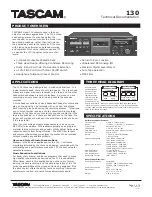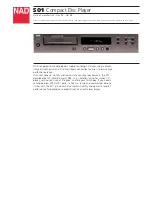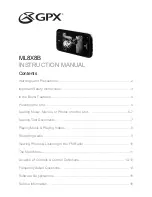
24
Tascam MMP-16 User’s Guide • Chapter 2 • Installation
MMP-16
Biphase Connections
Biphase is a control signal typically generated by a film projector and is traditionally used to interlock the
operation of the film with sprocketed magnetic tape machines. The Biphase Operations Board (BOB) on
the back panel of the MMP has four biphase input connections and one biphase output connection for
synchronizing the operation of the MMP-16 to film transports. Use Setup Menu 100, Sync Group, to
select which of the four Biphase inputs (Sync Groups) will control the system. The biphase connections
use 6-pin modular RJ-12 connectors (like those used on commercial phone systems) and twisted multi-
pair cabling (Category 5 Ethernet). Up to 100 feet of cable can be typically run from a biphase device to
the MMP-16 or vice versa. The pinout diagram for these connectors is given in Appendix D: Cable
Information.
Unlike time code, Biphase gives only speed and direction and does not contain an absolute
address. To set the MMP to lock to biphase, or to be a biphase master device, use Setup Menu
000, Control Mode. The various biphase parameters such as frame rate, pulse rate, acceleration, etc. are
set in the 300 series Setup Menus.
Not intended for public telecommunications network connection.
Digital Audio Sample Reference Connections
In combination with a frame reference for video and film, there may also be a sample reference for the
audio. The sample reference can be taken from the digital input 1&2 on the Digital output cable, the
frame reference, the Word Clock input (if there is an active signal on that input), or the system’s internal
clock source. These connections are described here in more detail.
Word Clock
Word Clock is a digital reference signal used by many digital editors and digital tape machines. This
permits two digital audio devices to synchronize their sample clocks to facilitate digital audio transfers
between machines, and to insure that they are running at precisely the same sample frequency. The signal
is transmitted on an unbalanced coaxial cable that terminates into a BNC connector at the MMP-16 end.
The MMP-16 has both a digital WORD CLOCK IN and a digital WORD CLOCK OUT connection using
BNC connectors.
When an external tape machine is to control the sample rate of the MMP-16, connect the Word Clock
output from that machine to the WORD CLOCK IN on the MMP-16. When the MMP-16 is to control the
sample rate of an external machine connect the WORD CLOCK OUT from the MMP-16 to the Word
Clock In on the controlled machine. The maximum practical cable distance is up to 100 feet. Use setup
menu 002 to select the sample reference for the MMP-16 system. Normally this is a 48 kHz TTL-
compatible (5 volt) signal.
AES/EBU Sample Rate
To lock the digital sample clock to an AES digital audio source, the audio sample reference for the MMP-
16 can be taken from the digital audio input 1&2 pair on the connector used for the AES digital output.
Use setup menu 002 to select the sample reference for the MMP-16 system.
MIDI Connections
The MMP-16 has MIDI (Music Instrument Digital Interface) In, Out, and Thru connectors. These are
used for sending out MIDI Time Code and for controlling the transport functions of the MMP via MIDI
Machine Control.
Содержание MMP-16
Страница 1: ...MMP 16 Modular Multitrack Player D00000000A OWNER S MANUAL...
Страница 5: ......
Страница 6: ......
Страница 7: ......
Страница 8: ......
Страница 9: ......
Страница 41: ...36...
Страница 73: ...Tascam MMP 16 Owner s Manual Chapter 5 MMP 16 System ApplicationsMMP 16 68...
Страница 93: ...Tascam MMP 16 Owner s Manual Appendix A Control Panel Summary 88...
Страница 95: ...Tascam MMP 16 Owner s Manual Appendix A Control Panel Summary 90...
Страница 119: ...Tascam MMP 16 Owner s Manual Index 114...
Страница 126: ...Tascam MMP 16 Owner s Manual Index 121...
















































